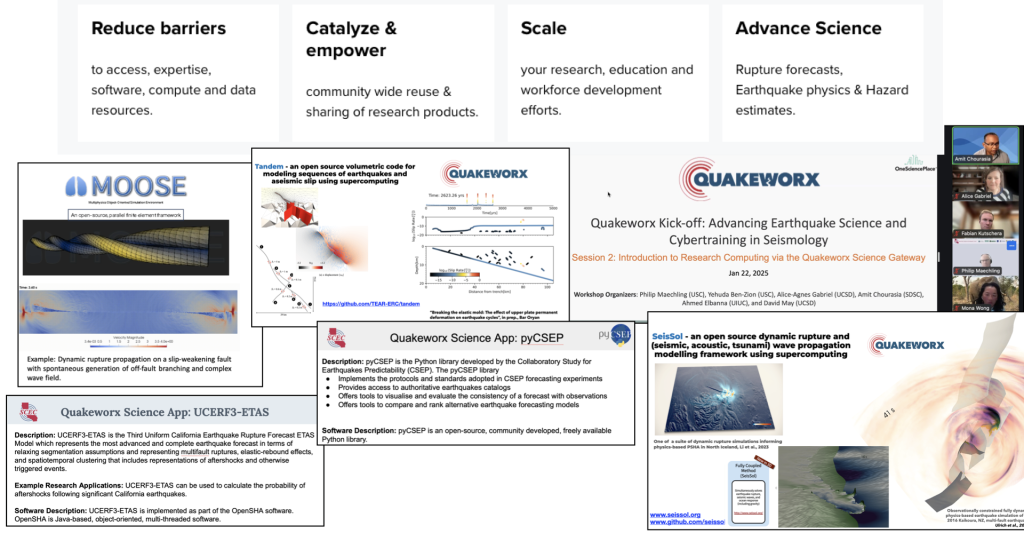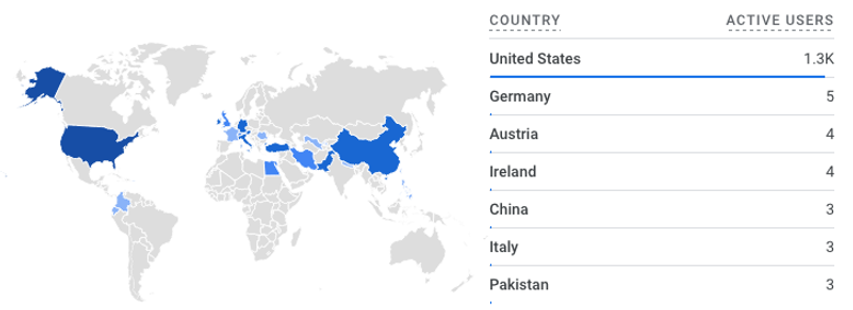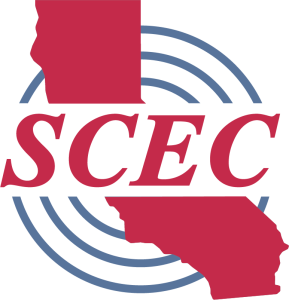By: Alice-Agnes Gabriel, Amit Chourasia, Philip Maechling, David A. May, Ahmed Elbanna, Yehuda Ben-Zion
Published April 23, 2025
The Quakeworx Kick-Off Workshop, held virtually from January 21-24, 2025, brought together 65 researchers from 16 countries to learn how to access and run state-of-the-art earthquake simulation software through the Quakeworx Science Gateway. This new browser-based platform provides user-friendly access to high-performance computing (HPC) resources and curated research codes for computational seismology. We aim to enable the next generation of scientists to use advanced simulations of seismic rupture dynamics, wave propagation, and earthquake forecasting without installing software locally.
Quakeworx Science Gateway
Science gateways (Lawrence et al., 2015; Barker et al., 2016) lower the entry barriers for researchers across disciplines by integrating HPC resources with user-friendly interfaces. These platforms leverage HPC/Cloud computing, distributed computing, and advanced middleware frameworks to ensure scalability and efficiency. The Quakeworx Science Gateway (UC San Diego Today) is an NSF-supported initiative designed to advance earthquake science through computational research and cybertraining. It is tailored for research on dynamics of seismicity, enabling users to run earthquake simulations, forecast aftershocks, and analyze seismic hazard models, aiming to democratize access to Computational Seismology on these topics.

The Quakeworx gateway, developed on the OneSciencePlace platform (OneSciencePlace, 2025), enables participants to launch containerized apps (e.g., SeisSol (Heinecke et al., 2014), Tandem (Uphoff et al., 2022), Moose-FARMS (Zhao and Elbanna, 2023), UCERF3-ETAS (Field et al., 2017), and pyCSEP (Savran et al., 2022), submit simulations to systems like SDSC’s Expanse cluster, and visualize results through an integrated web interface. An important feature of science gateways is their support for FAIR (Findable, Accessible, Interoperable, Reusable) data principles (Wilkinson et al., 2017). Quakeworx adheres to these principles by enabling structured metadata, standardized input/output formats, and seamless data sharing between researchers.
Cybertraining for Computational Seismology
Hosted by the Statewide California Earthquake Center (SCEC) in collaboration with the University of California San Diego, San Diego Supercomputer Center, University of Illinois Urbana-Champaign, and others, the four-day workshop featured morning sessions that combined lectures and live hands-on tutorials. Day 1 focused on principles of open science, including access to seismological datasets and software best practices. On Day 2, attendees learned about OneSciencePlace and its concepts, then created their own apps and ran interactive or batch simulations using the gateway. Days 3 and 4 highlighted research applications: SeisSol for dynamic rupture modeling, Tandem for multi-cycle simulations, Moose-FARMS for multiphysics rupture mechanics, UCERF3-ETAS for aftershock forecasting, and pyCSEP for evaluating earthquake forecast.

(over 1,300 visitors worldwide)
Interest in the training far exceeded expectations, with 162 applications for 65 slots. Of the selected attendees, 92% were students or postdocs, and 56% identified as women. Participant engagement was strong, with 84% logging in to run over 400 HPC jobs during the workshop. Post-workshop surveys showed 95% planned to use Quakeworx in their future research, and 100% would recommend the workshop to a colleague. Participants specifically highlighted the accessibility of the curated applications, the hands-on exercises, and the seamless integration of HPC resources.
In the coming months, the Quakeworx team plans to broaden the Quakeworx community, integrate new applications (e.g., the SCEC Broadband Platform), enhance gateway functionality, and offer advanced training modules. The platform will also integrate machine learning algorithms for automated pattern recognition and validation, allowing for real-time seismic hazard analysis. The Quakeworx Science Gateway has entered early user phase and plans for production release and general availability in Fall of 2025. We welcome interest from users (including faculty, students and staff) eager to test and provide feedback and use it for their research and teaching.
By lowering barriers to computational seismology, Quakeworx is building a collaborative, accessible foundation for computational earthquake science. All workshop material is available on the Quakeworx Workshop website, and recordings of all sessions are published on YouTube.
Acknowledgements
We specifically thank the students, postdocs, staff, and collaborators who were instrumental in preparing and conducting the workshop including: David Benham (San Diego Supercomputer Center (SDSC)), Akash Bhatthal (Statewide California Earthquake Center (SCEC)), Scott Callaghan (SCEC), Iris Christadler (Ludwig-Maximilians-Universität München (LMU)), Tran Huynh (SCEC), Piyush Karki (LMU), Fabian Kutschera (UCSD), Pascal Meunir (SDSC), Kevin Milner (United States Geological Survey (USGS)), Zihua Niu (LMU), Bar Oryan (UCSD), Edric Pauk (SCEC), Francesco Serafini (University of Bristol), Ilya Shunko (SDSC), Fabio Silva (SCEC), Mei-Hui Su (SCEC), Napat Tainpakdipat (UIUC), Max Werner (University of Bristol), Mona Wong-Barnum (SDSC), Choonhan Youn (SDSC), Jeena Yun (UCSD), Chunhui Zhao (UIUC).
Support for this project is from the National Science Foundation Awards 2311206, 2311207 and 2311208.
References
- Barker, M., S.D. Olabarriaga, N. Wilkins-Diehr, S. Gesing, D.S. Katz, S. Shahand, S. Henwood, T. Glatard, K. Jeffery, B. Corrie, A. Treloar, H. Glaves, L. Wyborn, N.P. Chue Hong, A. Costa (2019), The global impact of science gateways, virtual research environments and virtual laboratories, Future Generation Computer Systems, Volume 95, Pages 240-248, ISSN 0167-739X, doi:10.1016/j.future.2018.12.026.
- Field, E. H., Milner, K. R., Hardebeck, J. L., Page, M. T., van der Elst, N., Jordan, T. H., et al. (2017), A Spatiotemporal Clustering Model for the Third Uniform California Earthquake Rupture Forecast (UCERF3‐ETAS): Toward an Operational Earthquake Forecast. Bull Seismol Soc Am.;107: 1049–1081. doi:10.1785/0120160173
- Heinecke, A., A. Breuer, S. Rettenberger, M. Bader, A. Gabriel, C. Pelties, A. Bode, W. Barth, X. Liao, K. Vaidyanathan, M. Smelyanskiy, and P. Dubey (2014), Petascale high order dynamic rupture earthquake simulations on heterogeneous supercomputers, ACM Gordon Bell Prize Finalist, SC14 Proceedings of the International Conference for High Performance Computing, Networking, Storage and Analysis, 3–14 (2014). doi: 10.1109/SC.2014.6.
- Lawrence, K. A., Zentner, M., Wilkins-Diehr, N., Wernert, J. A., Pierce, M., Marru, S., and Michael, S. (2015), Science gateways today and tomorrow: positive perspectives of nearly 5000 members of the research community. Concurrency Computat.: Pract. Exper., 27: 4252–4268. doi: 10.1002/cpe.3526.
- OneSciencePlace – OneSciencePlace® – a composable platform for delivering research computing, data management and repositories. Retrieved Apr 11, 2025 from https://onescienceplace.org
- Uphoff, C., D. A. May, and A.-A. Gabriel (2022), A discontinuous Galerkin method for sequences of earthquakes and aseismic slip on multiple faults using unstructured curvilinear grids, Geophysical Journal International, doi:10.1093/gji/ggac467.
- Wilkinson, M. D., et al (2016), The FAIR Guiding Principles for scientific data management and stewardship, Nature (London), 3(1), 160018, doi:10.1038/sdata.2016.18.
- Zhao and Elbanna (2023), “FARMS” : Fault And Rupture Mechanics Simulations, https://github.com/chunhuizhao478/farms.
